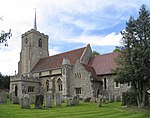Furneux Pelham

Furneux Pelham or Furneaux Pelham is a village and civil parish in Hertfordshire, England. The village is one of the Pelhams, part of an early medieval larger swathe of land known as Pelham including Brent Pelham to the north and Stocking Pelham to the east and north-east. The village is largely linear covering much of the width of the parish from east to west and is buffered by gently sloped fields with some woodland to all sides. It is known for its ford (Violet's Lane) to the north along the upper Ash which is over 1 kilometre (1,100 yd) long traversable by 4x4 enthusiasts most of the year and in the periods of least flow by experienced off-road motorcyclists.
Excerpt from the Wikipedia article Furneux Pelham (License: CC BY-SA 3.0, Authors, Images).Furneux Pelham
The Causeway, East Hertfordshire Furneux Pelham
Geographical coordinates (GPS) Address Nearby Places Show on map
Geographical coordinates (GPS)
| Latitude | Longitude |
|---|---|
| N 51.931 ° | E 0.08 ° |
Address
The Causeway
The Causeway
SG9 0LW East Hertfordshire, Furneux Pelham
England, United Kingdom
Open on Google Maps








